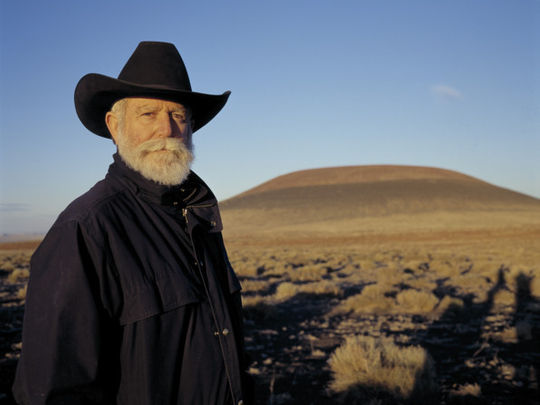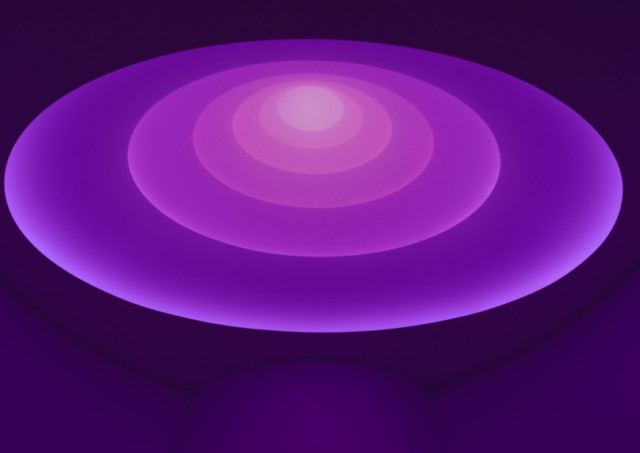
“James Turrell: A Retrospective” is a bit like a dinner party at which the guest of honour is absent. Family members and friends are there, plus lots of conversation about the one who’s missing. But the primary impetus for the get-together couldn’t make it.
The missing guest, of course, is Roden Crater — the much written-about volcano in the Northern Arizona desert that the artist has been converting into an elaborate, celestial observatory since he located the dramatic site more than 40 years ago.
The exhibition at the Los Angeles County Museum of Art includes extensive documentation of the ongoing project, in the form of models, drawings, plans, photographs and video. (A separate exhibition about Roden Crater is also at Kayne Griffin Corcoran Gallery.) When it might be completed is not known.
But the show gives a good sense of Turrell’s artistic trajectory, primarily from ten abstract light-installations that explore perceptual phenomena. His work quickly built on innovations by slightly older Light and Space artists Robert Irwin and Doug Wheeler. (Who did what, when, is often contested.) The earliest piece dates from 1966, while the most recent one was commissioned for the retrospective.
“Afrum (White)” (1966) is an intense beam of white light from a projector hidden in the ceiling, which creates an illusion of geometric form in a corner across the room. “Breathing Light” (2013) is a walk-in environment — an elevated white room with curved corners, reached by climbing an imposing stairway and flooded with indescribable colours from a computer-driven sequence of changing electric lights.
In both works, the art finally exists within a viewer’s eye, rather than outside it. Looking at an artwork gives way to being immersed within its perceptual gymnastics and, finally, seeing oneself see.
Light, the essential ingredient for sight, is Turrell’s principal medium. Spiritual perception is his art’s aim. The ancient metaphor of light as the engine of enlightenment is conjured in a modern way.
It is easy to get lost in that metaphor too, given its affinities for the vague abstractions of New Age spirituality. Sometimes the art is overwhelmed by science, with a viewer feeling reduced to the helpless condition of lab rat.
Yet, spiritual perception has a long tradition in American art. It dates at least to the mid-19th century.
“I become a transparent eyeball,” Ralph Waldo Emerson deliriously wrote in “Nature”, his celebrated 1836 essay on transcendentalist philosophy. “I am nothing; I see all; the currents of the Universal Being circulate through me — I am part or particle of God.”
Painters such as Fitz Henry Lane, Martin Johnson Heade and John Frederick Kensett organised their landscape views according to mathematical principles of geometry, infusing the idealised forms with exquisite luminosity. In fact, one way to think about Turrell’s work is as the illumination of an interior landscape, rather than the external one of his painting forebears.
However, in addition to paintings such as Lane’s or Kensett’s, a different mid-19th century development seems very much to the point. Turrell’s art resonates with the 1839 invention of photography, sometimes called “the art of fixing shadows”.
The long arc of camera history exploded in the 1960s, when Turrell’s work began to coalesce. Inexpensive Polaroids made “fixing shadows” common and instantaneous; digital cameras waited in the wings to join analogue ones for amateur use; and, a spellbound world watched live pictures of an extraterrestrial man walking on the moon, bathed in reflected light. Cameras became the image technology defining contemporary life.
Turrell’s retrospective even starts with a camera, though you will need to look closely to find it. Documentation describes “The Mendota Stoppages”, a pivotal environment Turrell developed from 1969 to 1974. Rooms in an old Santa Monica hotel were sealed off, the window apertures controlled by the artist to allow natural and artificial light to enter the darkened spaces in specific ways.
The piece was long ago dismantled (the building now houses a Starbucks). But “The Mendota Stoppages” was essentially a giant camera obscura, a rudimentary image-making device as old as Aristotle.
“Afrum (White),” the mesmerising and beautiful projection piece in the second gallery, shows how conceptually dizzying Turrell’s best work can be. A six-sided geometric shape is projected into the corner of a white room.
Visually, the projection reads multiple ways: It is a flat hexagon of light, a three-dimensional illusion of a protruding cube and an actual receding corner of the room. A viewer’s consciousness shifts accordingly, slipping and sliding among image, object and space in a struggle to pull them into a stable, harmonious whole.
“Juke (Green)”, a slightly later corner projection that creates a wedge of green light, is less successful. A rather inert display, its primary virtue is the introduction of colour into the artist’s developing repertoire.
The survey’s loose chronology then momentarily jumps ahead four decades to a group of nine holograms made in 2008-2009. As you move past the glass panels, both large and small, wedges, disks and planes of rainbow colour appear to unfold and disappear in atmospheric space. Adding little of consequence to the familiar, gee-whiz laser technique, they are the show’s least satisfying works.
Other installations elaborate on the physics of optical perception. Some make wry allusions to television screens. Others create a labyrinth effect — visual doorways that seem to open into uncharted spaces, which can be entered only by imagination. Turrell’s art exists at an intersection of science and fiction.
The number of visitors that can be allowed into many of these chambers at one time is limited. In the pitch black “Dark Matter”, where minimal ambient light causes a strange knot of hovering grey to float within the inkiness, only two people can be accommodated at once.
Also, a suggested minimum amount of time to allow for the visual effects to occur is printed at each installation’s entry, meaning that a few hours are necessary to see the entire show. (That is one reason for its extended run: The elaborate exhibition continues until next April.) Expect to wait in line.
Turrell, 70, apparently produced little or no portable work for long periods. Especially sparse is work from the 1970s and 1990s, presumably because of preoccupation with developing Roden Crater.
He was also executing commissions for private and public installations. About 100 “sky spaces”, Turrell’s name for observatory works related to the volcano, have been built around the world.
The retrospective, organised by LACMA director Michael Govan and curator Christine Y. Kim, is of necessity more a sampler from the past 47 years. Smaller, independently organised Turrell shows also open soon at Houston’s Museum of Fine Arts and New York’s Guggenheim.
The most appealing works at LACMA are usually the simplest, such as “Afrum” or “Raemar” — the latter a wide, floating wall that becomes a screen for subtle optical effects produced by eyes fatigued by surrounding pink fluorescent light. Others, such as a spherical chamber that an individual viewer enters on a sliding bed to experience an intense, 12-minute bombardment of flashing light, merely seem grandiose. (Titled “Light Reignfall”, the MRI-like sphere requires advance ticketing and a signed waiver.)
Finding equilibrium isn’t easy, and Turrell’s art doesn’t always manage it. When it does, though, the work opens a philosophical mind as much as a transparent eye.
–Los Angeles Times
“James Turrell: A Retrospective” is on at the Los Angeles County Museum of Art, until April 6, 2014.



